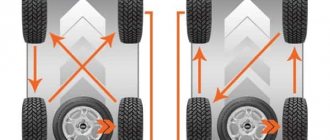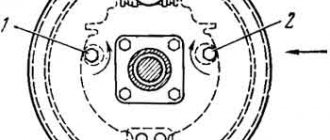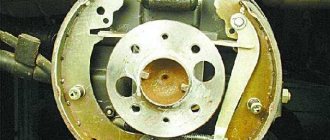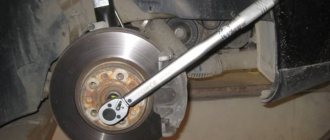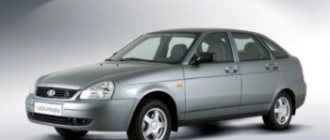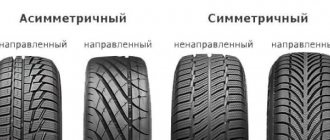When operating a car, it is important not only to take care of the tires - maintain pressure in them, monitor for the appearance of mechanical damage, but also to perform such a simple but very important procedure as rotating the wheels. Depending on different operating conditions, technical characteristics and other parameters of the vehicle, one or another wheel replacement scheme may be used.
Buying a second set of wheels is quite a burden on the budget, so every car owner should strive to extend the life of the tires. Following the recommendations of professional tire specialists will allow you to ensure the most even tread wear and significantly extend the life of your tires.
When is wheel rotation recommended?
All recommendations for car maintenance are indicated in the operating manual. By the way, there is also a diagram for replacing tires when and how to change the wheels on a car. Therefore, to make the right decision, read the instructions carefully.
With regular and correct wheel changes, the most uniform tread wear is achieved. When to swap wheels? Often the change is made during scheduled maintenance. Manufacturers recommend doing this once every 20 thousand km. mileage
If the traffic is carried out mainly on bad roads, replacement is carried out every 10 thousand km. The same rule applies to those motorists who are accustomed to an aggressive driving style. It is recommended to directly replace the wheels according to the scheme shown in Fig. 2.
Rice. 2
Rotation period
The wear pattern of the front and rear tires is different; the edges of the tread wear off on the front tires, while the rear tires lose the middle part. Timely rotation of the wheels will make it possible to make this wear more uniform: the rear tires will begin to wear on the sidewalls, while the front tires will begin to wear off along the plane. Of course, you can simply replace the front tires with new ones if you have enough extra money, but it is easier to simply swap the tires, extending their life by one and a half times. Moreover, tire manufacturers themselves advise rotating tires every six months or every ten thousand kilometers. And in order to do this, you don’t have to take separate additional actions, because every six months we already change our cars from summer to winter tires and back. You'll just have to swap them around.
Preparatory stage
Of course, you don’t have to worry about how to properly swap wheels, but simply entrust this work to specialists in a car service center. But you should remember that:
- this kind of work costs money;
- there is no guarantee that the technician will make the replacement correctly;
- You will always have to contact the same car service center.
Meanwhile, you can do everything yourself. In order to rotate the wheels technically competently, to perform all operations independently, without resorting to the services of a car service, it is necessary to carry out certain preparatory measures:
- We prepare the necessary tools: a jack, a stand, a wheel wrench.
- We place the car on a flat surface with a hard surface.
- Selecting the correct permutation scheme.
If you have a little practical experience, changing wheels from a set of tires will take 1.5-2 hours, no more.
How much does it cost to rotate wheels?
The good news is it's inexpensive. This small investment comes back to you in the form of long tire life and continued vehicle safety and performance. In the long run, the cost of rotating your tires periodically will be only a fraction of what you would have to spend on new tires due to premature wear.
Tire shops also often offer tire rotation services at a discount for regular customers or from time to time offer to do it for free. So contact the tire shop that installed your tires first - in some cases, your cost for tire rotation may be zero.
Helpful Hint: Don't forget to label your wheels with numbers and keep your tire rotation data and receipts. If you ever need to have your tires replaced under warranty, having these records will improve your chances of success.
How to swap wheels
Before changing wheels, it is important to choose a scheme for performing the operation. It is recommended to evaluate all the advantages and positive aspects of the process and predict possible shortcomings in advance.
It is important to understand that the work performed by the tires on the front wheels is significantly different from that assigned to the tires on the rear wheels. First of all, this is due to the level of load. A car with sporting parameters and characteristics usually wears out its tires more intensively.
If, as a result of periodic inspection, it is determined that the tires of all 4 wheels wear evenly, it is recommended to purchase a whole set and change the tires according to the selected wheel replacement scheme.
But before you start exploring different options, a little advice. Before removing the summer or winter set and performing a seasonal wheel rotation, it is recommended to first mark the tires (with chalk or water-based paint). This will help you figure out later which side and on which axis the tire was previously located.
Tire manufacturers recommend using the following symbols:
- PP (right anterior);
- PL (front left);
- ZP (rear right);
- LR (rear left).
How to properly change winter tires
Winter modifications do not have any special requirements for the replacement sequence.
Thus, the symmetrical studded or Velcro version must be rearranged according to the standard pattern, respecting the direction of the tread. Some buyers ask whether studded tires can be rearranged. The answer is that metal inserts do not affect the wear of the rubber itself.
Wheel rotation scheme
The choice of the preferred wheel rotation pattern is influenced by the tread pattern (tires with a directional tread pattern), the presence of a spare wheel in the trunk, and the type of vehicle drive.
For rear wheel drive cars
If everything is done at a car service center, the entire car is hung on a lift, and a spare tire is not required. When using a jack, you will need a spare tire to keep the vehicle stable.
After removing the left rear wheel, a spare tire is temporarily installed in its place. Next, the front left, rear right and front right wheels are changed sequentially. After finishing the work, the spare wheel is installed in its place - in the trunk.
Rice. 3
For all-wheel drive vehicles
The procedure for all-wheel drive vehicles is similar. But there is also an option - install a spare tire and gradually wear it out simultaneously with the four other wheels. It is more suitable for cases when it is not possible to buy a new set, or when you simply feel sorry for money.
Rice. 4
For front wheel drive cars
Here it is recommended to swap tires by choosing one of two possible options:
- According to the circular cross system.
- According to the cross pattern.
Rice. 5
Where can I buy good wheels?
You can buy wheels for a semi-trailer by simply visiting the websites of wholesale suppliers, or at manufacturers' dealerships. Finding out how much it will cost is also easy. The best thing is to call the sellers at the numbers indicated on the websites and find out the details and terms of purchase. It is difficult to find competent reviews about the wheel models offered.
Truck wheels experience impressive loads every day. And their mileage is calculated in the six-digit number of kilometers. Therefore, the correct choice of tires will allow drivers to significantly improve the technical parameters of their vehicles and obtain the proper level of comfort, improved handling and fuel economy.
Note that the cheapest part of the design will be the hub of the MAZ semi-trailer.
You can buy alloy wheels, Replica wheels and car tires at affordable prices in the Spbkoleso online store. We deliver goods throughout St. Petersburg and the region, and also send goods to the regions with full prepayment of the order.
Why is this necessary?
Car tire wear is uneven. Let's start with the fact that the front wheels deteriorate faster than those placed on the rear. After all, the front of your car accounts for about 60% of the total weight. The wear of tires placed in front is also affected by turns. When driving on the right side of the road, we turn much more to the left than to the right.
Consequently, the right front tire is subject to wear more than others. Rearranging the wheels will help. This will provide you with significant cost savings on car maintenance and predictable steering effort. And, like a real man, you can change the tires on your car yourself. Not necessarily in pursuit of savings, but even so that your significant other sees that even in a “white collar” there is a man inside.
Asymmetrical non-directional tread pattern
The most popular type of tread on civilian tires at the moment is asymmetrical.
.
This, for example, is the case with most models of the MICHELIN summer line, ranging from economical to sporty. When installing asymmetrical tires on rims, it is necessary to align the front side of the tire with the front side of the rim
: for this purpose, the outside and inside inscriptions are present on the sidewalls (the outer and inner side of the tire) and there is no rotation direction arrow.
The convenience of this type of tread is that the wheel assembly can be changed between each other in any way: the outer side of the tire will remain external in any case
. In this case, it is appropriate to use any of the rotation methods. Usually the most suitable method for rearranging wheels is indicated in the car's operating instructions, but if you don't have one on hand, you can choose one of the methods we suggest.
Method 1
The front left wheel changes with the rear right one, and the front right wheel changes with the rear left one. This type of replacement is suitable for any type of vehicle drive and is most preferable for all-wheel drive vehicles.
Method 2
The rear wheels are moved to the front axle (the right rear wheel is placed in place of the right front one, the left rear wheel is placed in place of the left front one), while the front wheels are installed in place of the rear ones diagonally (the right front wheel is placed in place of the left rear one, the left front wheel is placed in place of the front axle). right rear seat). This method is suitable for cars with rear-wheel drive and all-wheel drive.
Method 3
The front wheels are installed in place of the rear ones (the right front wheel is in place of the right rear wheel, the left front wheel is in place of the left rear wheel), and the rear wheels, in turn, are moved diagonally to the front axle (the right rear wheel is placed in place of the left front wheel, the left rear - in place of the right front). This method is intended for cars with front-wheel drive.
Symmetrical directional tread pattern
Such tires are becoming less and less common in summer tire lines and are almost always winter tires: the V-shaped tread makes it possible to remove water from the contact patch as efficiently as possible. Thus, in the MICHELIN model range, CrossClimate summer tires and a number of winter tires (Latitude X-Ice 3, Alpin 5, etc.) have a directional tread pattern. Rotation with directional tires installed on the rims can be done in only one way: by swapping the front and rear wheels, i.e., the front left wheel in place of the rear left one, the front right wheel in place of the rear right one.
